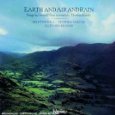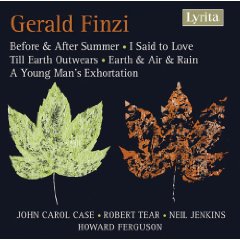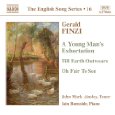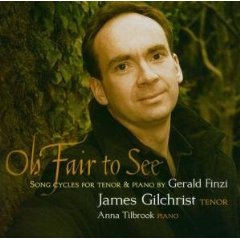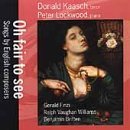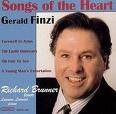Life Laughs Onward
- Musical Analysis Section
- Audio Recordings Section
- Unpublished Analysis Excerpts
- Gerhardus Daniël Van der Watt - The Songs of Gerald Finzi (1901-1956) To Poems by Thomas Hardy
- Mark Carlisle - Gerald Finzi: A performance Analysis of A Young Man's Exhortation and Till Earth Outwears, Two Works for High Voice and
- Leslie Alan Denning - A Discussion and Analysis of Songs for the Tenor Voice Composed by Gerald Finzi with Texts by Thomas Hardy
Poet: Thomas Hardy
Date of poem: (undated)
Publication date: In the collection: Moments of Vision on November 30, 1917
(Seymour-Smith, 848)
Publisher: Macmillan Publishing Company
Collection: Moments of Vision and Miscellaneous Verses (1917)
History of Poem: Mark Carlisle writes in his dissertation: "This poem was published as another in Hardy's collection, Moments of Vision. "Life laughs onward" was written in the months shortly after Emma Hardy's death, when Thomas had returned to Cornwall to revisit the sites of their earlier, happier days together. It describes several of these places, and remarks on how much the places had changed since the two of them had been there years before. The second verse probably describes Emma's grave in Stinsford Churchyard, as she was particularly fond of daisies, and likewise, Emma was surely the "figure" that had "once sat upon the terrace." Hardy was seventy-seven years old when this set of poems was published, and this particular one reflects not only his realization that the young will forever replace the old, such as himself, but also that this concept is acceptable to him." (Carlisle, 74-5)
Poem
| 1 | RAMBLING I looked for an old abode | a |
| 2 | Where, years back, one had lived I knew; | b |
| 3 | Its site a dwelling duly showed, |
a |
| 4 | But it was new. | b |
| 5 | I went where, not so long ago, |
c |
| 6 | The sod had riven two breasts asunder; | d |
| 7 | Daisies throve gaily there, as though | c |
| 8 | No grave were under. |
d |
| 9 | I walked along a terrace where | e |
| 10 | Loud children gambolled in the sun; | f |
| 11 | The figure that had once sat there | e |
| 12 | Was missed by none. | f |
| 13 | Life laughed and moved on unsubdued, |
g |
| 14 | I saw that Old succumbed to Young: |
h |
| 15 | ‘Twas well. My too regretful mood | g |
| 16 | Died on my tongue. | h |
(Hardy, 463-4) |
||
Content/Meaning of the Poem:
1st stanza: I wandered around leisurely looking for an old home, where, years ago, a person I knew had lived; when I found the site there was a new home there.
2nd stanza: I went to a grave that not so long ago was buried a girl; daisies were flourishing there as if no one was buried below.
3rd stanza: I walked along a terrace and witnessed loud children dancing and frolicking in the sun; the one I remembered from long ago who had sat in the same place, no one now knew.
4th stanza: Life goes on without any thought for the past, the images of the past are erased by the present: This is how it should be. My regrets for what had been, were gone.
Gerhardus Daniël Van der Watt makes the following comments about the text of Life Laughs Onward: "The persona of the poem, not necessarily the poet, visits a sight where he believes the home of a departed acquaintance, to be. The house he knew does not exist any longer and in its place a new one has been erected. Not even the friend's grave is visible, there are wild flowers obscuring it. The persona meets some of the new inhabitants: noisy children, none of whom miss the previous inhabitant. These observations have a surprisingly positive outcome. The persona realizes that life continues, unperturbed by his personal feelings of regret. Age must make way for youth - and age-old natural principle - and with this realization the persona's gloomy mood vanishes." (Van der Watt, 408) To view additional comments by Dr. Van der Watt as to the possible meaning of the text please refer to: Content - Van der Watt.
Speaker: Possibly Thomas Hardy
Setting: F. B. Pinion writes: "All the sites seem to be connected with Emma: Plymouth, her grave at Stinsford (daisies her favorite flower), and the terrace in the rectory garden at St Juliot or by the river at Sturminster Newton, which Hardy revisited in June 1916." (Pinion, 132)
Purpose: The poet reminds us that what we have in the present is soon forgotten in the future.
Idea or theme: Memories of a lost love.
Style: Written in a lyrical and narrative style according to Gerhardus Daniël Van der Watt. (Van der Watt, 409)
Form: Gerhardus Daniël Van der Watt writes in his dissertation, "The poem consists of four quatrains the final line of each being shortened. The rhyme scheme is rounded: abab cdcd efef ghgh. The textual metre is mainly iambic with a spondaic instance in each stanza. A number of effective contrasting images or concepts occur in the poem."
Stanza 1 |
"Old . . . new" - referring to the house |
|
Stanza 2 |
"breasts asunder . . . Daisies throve gaily" - death/life contrast |
|
Stanza 3 |
"Loud children . . . figure" - active, young/passive, old contrast |
|
Stanza 4 |
"Old . . . Young" "Life laughed . . . regretful mood" |
|
(Van der Watt, 409)
|
||
Synthesis: In the poem we find the speaker reminiscing about things in the past and how when he visits locales of his youth the memories are now altered by the present. At first the tone seems to be one of regret but eventually the speaker seems to grasp the idea that life must move forward. This poem was possibly therapeutic for Hardy after the loss of his first wife, Emma. Whether the various locations were autobiographical we do not know, but if they were, the tone in the last stanza seems to show that Hardy was attempting to accept the loss of Emma and move on with his own life.
Leslie Denning writes in his dissertation, "The presumably happy title 'Life Laughs Onward' is not indicative of the true intent of the song, which supposes Hardy's basic philosophy of mankind full of purpose, fighting against the purposelessness and unfriendly forces of nature. In reality, perhaps this is an example of Hardy's sarcasm." (Denning, 88) Gerhardus Daniël Van der Watt echoes some of the same comments about the tone of the poem and writes, "A potentially painful journey of remembering, turns into an uplifting experience for both persona and reader. The redeeming realization that life goes on despite private misfortunes or regrets, ends the poem positively." (Van der Watt, 409) Mark Carlisle referencing Hardy's age at the time the poem was published says, "Hardy was seventy-seven years old when this set of poems was published, and this particular one reflects not only his realization that the young will forever replace the old, such as himself, but also that this concept is acceptable to him." (Carlisle, 74-5)
Published comments about the poem: James Osler Bailey writes: " 'Life laughs onward' portrays Hardy's tendency to live much in his memories. He regrets that an 'old abode' has been replaced by a new. The second stanza seems to refer to his wife Emma's grave in Stinsford Churchyard. Emma had especially loved daisies, associated with her in a number of poems, as in 'Rain on a Grave.' The 'figure' that had once sat on a terrace may be Emma's. Hardy meditates that the new and young forever replace the old." (Bailey, 367)
✦✼✦✼✦✼✦✼✦✼✦✼✦✼✦✼✦✼✦✼✦✼✦✼✦✼✦✼✦✼✦✼✦✼✦
Moments of Vision
- Collection of 160 poems written by Thomas Hardy.
- Published in November of 1917 by Macmillan and Company.
- This volume is the largest collection of poems Hardy published.
- 15 of the poems had been previously published. Nine within Selected Poems of Thomas Hardy.
- The collection contains several poems attributable to the loss of Hardy's first wife Emma.
- Hardy inscribed a copy to Florence Hardy, his second wife. "From Thomas Hardy, this first copy of the first edition, to the first of women Florence Hardy. Nov. 1917"
(Wright, 220)
Hardy commented about the volume saying, "I do not expect much notice will be taken of these poems; they mortify the human sense of self-importance by showing, or suggesting, that human beings are of no matter or appreciable value in this nonchalant universe." (Pinion, 120)
F. B. Pinion comments about the poetry saying, "most are reminiscent; many are inspired by the memory of Emma Hardy." (Pinion, 120)
Gerald Finzi set the following poems within this collection:
- At Middle-Field Gate in February (I Said To Love)
- The Clock of the Years (dated: 1916) (Earth and Air and Rain)
- For Life I Had Never Cared Greatly (I Said To Love)
- In the time of 'The Breaking of Nations' [titled by Finzi as: Only a man harrowing clods]
- It Never Looks Like Summer (dated: March 8, 1913) (Till Earth Outwears)
- Life Laughs Onward (Till Earth Outwears)
- Overlooking The River Stour [titled by Finzi as: Overlooking the River] (Before and After Summer)
- The Oxen ( By Footpath and Stile)
- Paying Calls (By Footpath and Stile)
- Transformations (A Young Man's Exhortation)
- While Drawing in a Churchyard [titled by Finzi as; In a Churchyard] (Earth and Air and Rain)
Helpful Links:
✦✼✦✼✦✼✦✼✦✼✦✼✦✼✦✼✦✼✦✼✦✼✦✼✦✼✦✼✦✼✦✼✦✼✦
Musical Analysis
Composition date: 1955
Publication date: © Copyright © 1958 by Boosey & Co. Ltd.
Publisher: Boosey & Hawkes - distributed by Hal Leonard Corporation
Tonality: Finzi originally composed this song a major second lower than the published key of G major. A note was included in the Preface detailing the reason behind the transposition. It seems Finzi was uncertain to which voice type it belonged and so after his death the editors, Howard Ferguson, Joyce Finzi, and Christopher Finzi in 1957 decided to include this song in the tenor set, Till Earth Outwears. (Finzi, preface) The song begins and ends in G major but Finzi punctuates the four stanzas of the poems by moving away from G major to other tonalities. His first shift in tonality occurs in measure six where F major is introduced (see example below).
Shift in tonality to F major beginning in measure 6. (Finzi, 103)

Please also note in the example given above how Finzi inserts a B-flat into the first chord helping expedite the shift from G major to F major. The shift to F major is only a temporary one as Finzi transitions from the first stanza to the second. At the end of measure eight Finzi uses a Neapolitan chord built on the lowered E-flat in order to modulate to D major at the beginning of measure nine. This modulation coincides with the beginning of the second stanza of the poem (see example below).
Neapolitan chord and modulation to D major in measures 8-9. (Finzi, 104)

The second stanza remains in the key of D major but there is increased chromaticism underlying the text, "The sod had riven two breasts asunder; Daisies throve gaily there, as though No grave were under" (see example below).
Increased chromaticism in measures 10-3. (Finzi, 104)

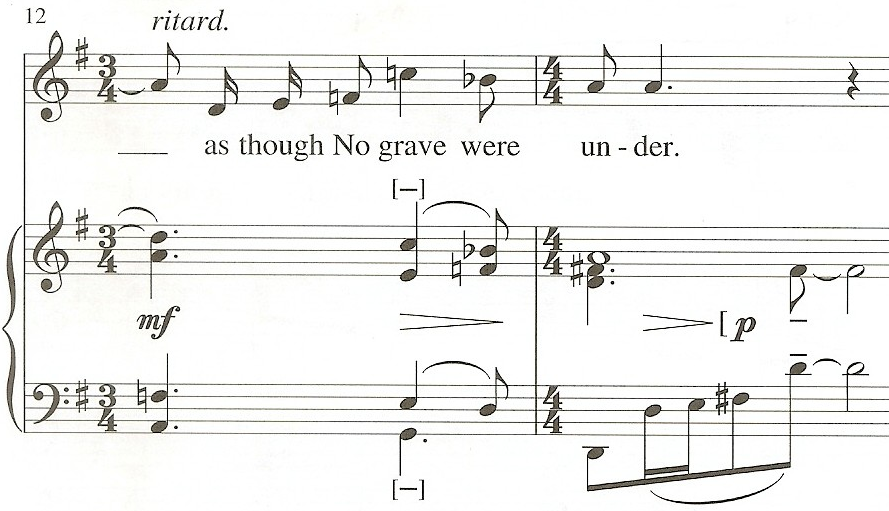
The end of the second section utilizes a half-cadence thus enabling G major to begin the third section of the song in measure fourteen even though it looks like Finzi was possibly preparing to establish G minor beginning in measure eleven and twelve with the inclusion of B-flat (see example above). Nevertheless he does not include the B-flat in measure fourteen and perhaps the reasoning behind him choosing the major mode over the minor was in support of the text as he prepares for "loud children playing in the sun" in measures fifteen and sixteen (see example below).
Modulation to G major and text support in measures 14-6. (Finzi, 104)
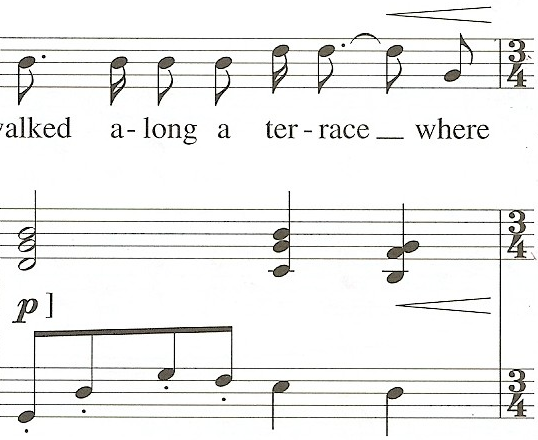
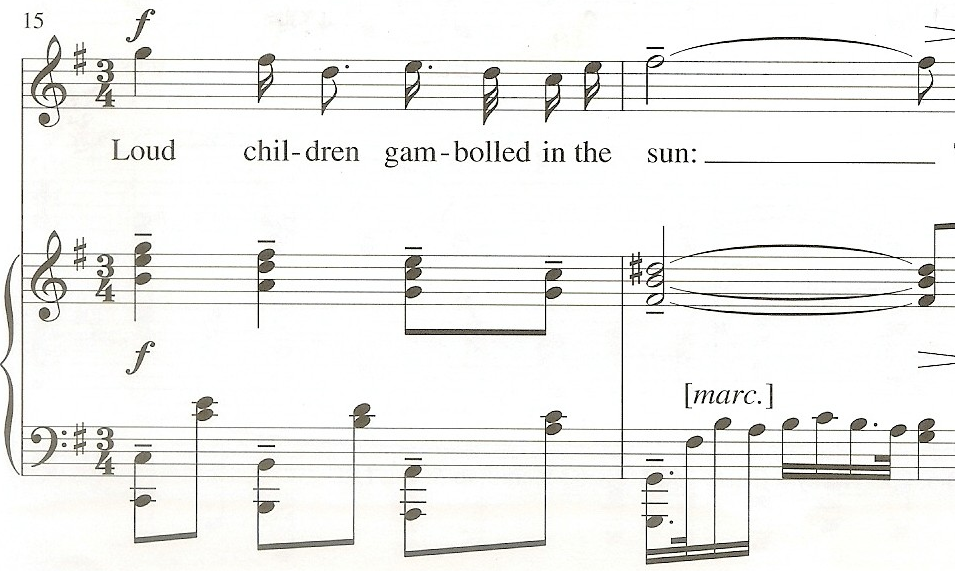
Measure fifteen also coincides with the climax of the song. In measure nineteen Finzi again begins to shift tonalities with the inclusion of G-sharp. It looked as if he was preparing to cadence in G by utilizing the dominant chord on the last eighth note chord in measure eighteen but instead we find an E major chord at the beginning of measure nineteen. Finzi writes a two measure interlude remaining in the new key of E major (see example below).
End of third section and interlude material in measures 18-20. (Finzi, 105)

At the beginning of the last section Finzi throws in a bit of a surprise when he introduces D-flat major without preparing the listener (see example below).
D-flat major at the beginning of last section in measures 21-2. (Finzi, 105)
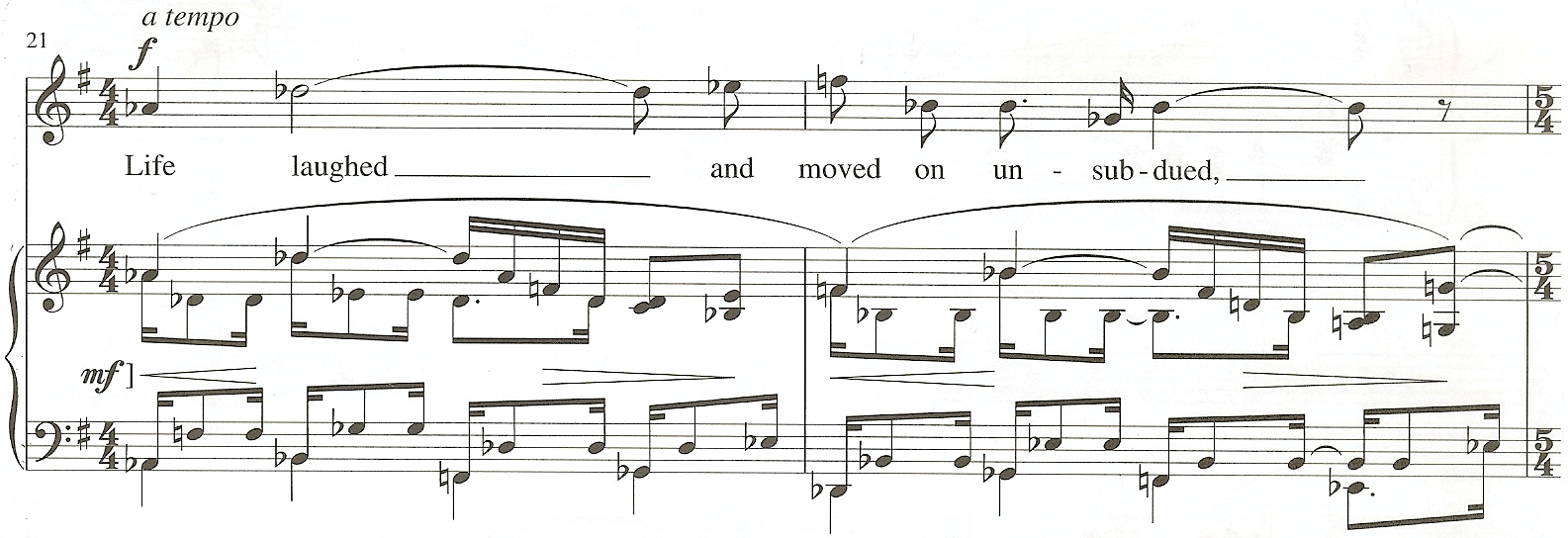
This modulation seems quite unusual but Mark Carlisle in his analysis points out that E major is the relative major for C-sharp minor and Finzi has simply used the enharmonic equivalent and at the same time substituted the major mode of D-flat in place of the minor mode. (Carlisle, 79-80) You may recall that Finzi substituted major for minor also in measure fourteen when it looked as if he was preparing to modulate to G-minor but instead moved to G-major. Finzi remains in D-flat major until the middle of measure twenty-three coinciding with the second line of the last stanza, "I saw that Old succumbed to Young." Finzi writes a dissonant chord at the beginning of measure twenty-four under the word "Young." In the right hand of the accompaniment he has written a D-sharp and then a diminished octave of D-natural above (see example below).
Dissonant chord in measure 24. (Finzi, 105)
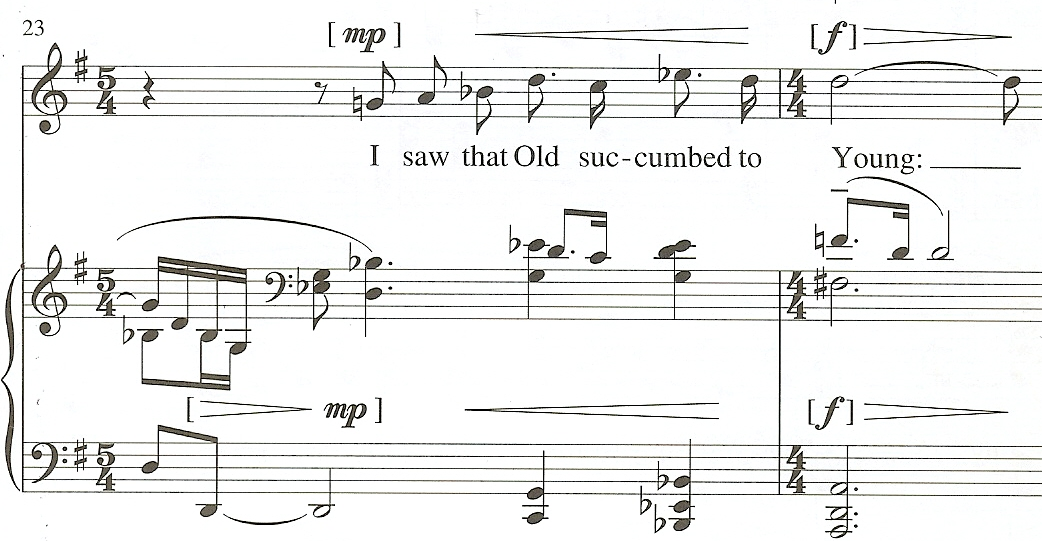
Then in order to modulate back to G major he has one and one half empty measures with no accompaniment simply allowing the vocal line to solidify the dominant by singing an octave D on the the text "Twas well" in measures twenty-four and twenty-five (see example below).
Modulation with vocal line only in measures 24-5. (Finzi, 105)
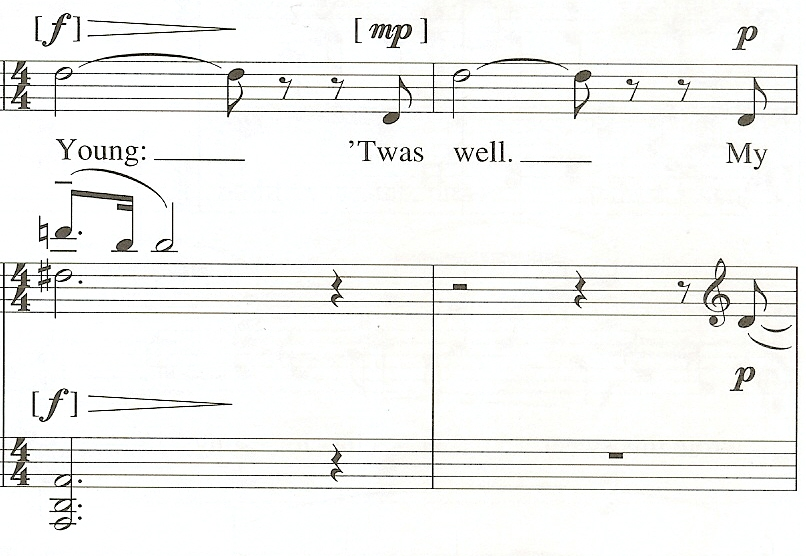
Finzi concludes the song in G major in a pastoral mood, just as the text has excepted the realization that the "old must give way to the young," so to Finzi writes what could be construed as an acceptance of this moral and restates the beginning theme (see example below).
Restatement of opening theme in measures 27-9. (Finzi, 105)
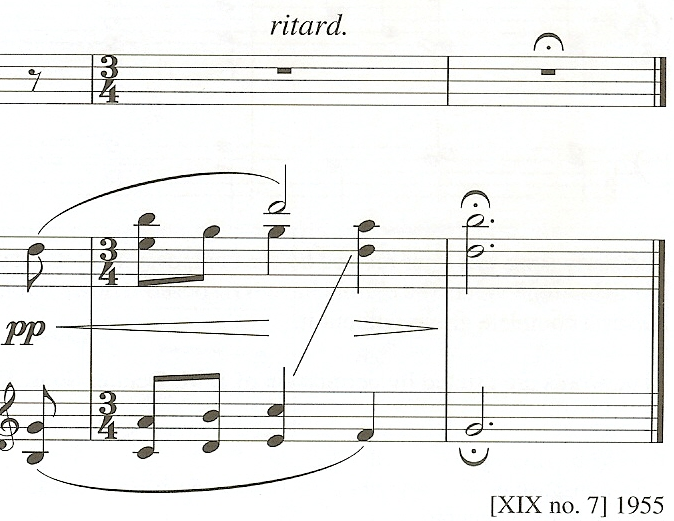
For additional information about the original key please refer to: Tonality - Van der Watt.
Transposition: The song is available in E Major a major second lower than the original key and a minor third lower than the original published key. The transposed version may be found in the Medium/Low Voice edition by Boosey & Hawkes entitled: Gerald Finzi Collected Songs 54 Songs Including 8 Cycles or Sets.
Duration: Approximately two minutes.
Meter: The song begins rather quietly with the first seven measures in 4/4 but after which Finzi makes thirteen shifts in twenty-one measures. The meter shifts are in support of the text almost always with one exception in measure twenty where Finzi chooses to write a 5/4 measure in an interlude. Mark Carlisle writes with regards to the "rapid sequence of meter changes" they "serve to allow for natural stressing of the text, and add much variety to the musical phrasing." (Carlisle, 75) 4/4 is used in total for eighteen measures or approximately two thirds of the song. 3/4 is the next most utilized coming in at six measures. 5/4 is used in four measures and 6/4 is used once in measure ten. For additional information about the meter within the song please refer to: Metre - Van der Watt.
Tempo: The opening tempo indication is Andante commodo with the quarter note equalling c. 60. The first deviation from Andante commodo is in measure ten where an accelerando is indicated corresponding to the text "The sod had riven two breast asunder." A ritard is indicated in measure twelve as the second stanza concludes with the text "as though No grave were under." A tempo is indicated to begin the third section of the song with the last beat in measure thirteen. There is a poco ritard in measure twenty before returning to a tempo in measure twenty-one which coincides with the beginning of the last section. The last deviation in tempo occurs in measure twenty-eight with a ritard as the song concludes. For additional comments about the tempi please refer to: Speed - Van der Watt.
Form: The song has four sections and can be best described as through-composed. There is however a motif which Gerhardus Daniël Van der Watt discusses in his analysis and labels as "refrain-like." Dr. Van der Watt has located the motif in measures three, eight, fourteen, nineteen (varied), twenty through twenty-one (varied), and lastly in measure twenty-six (Van der Watt, 416) (see examples below)
Musical motif in measures 3, 8, 14, and 26. (Finzi, 103-5)
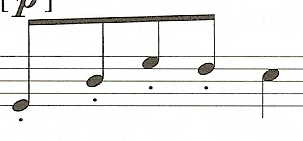
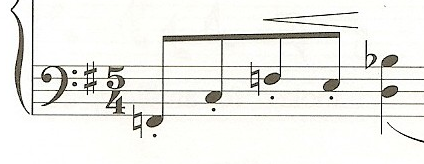
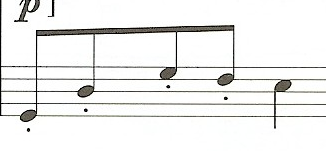

Another unifying musical element in the song is a theme that is heard twice in the prelude and once in the postlude, thus framing the song (see example below)
Theme in measures 1-2 and 27-8. (Finzi, 103, 105)
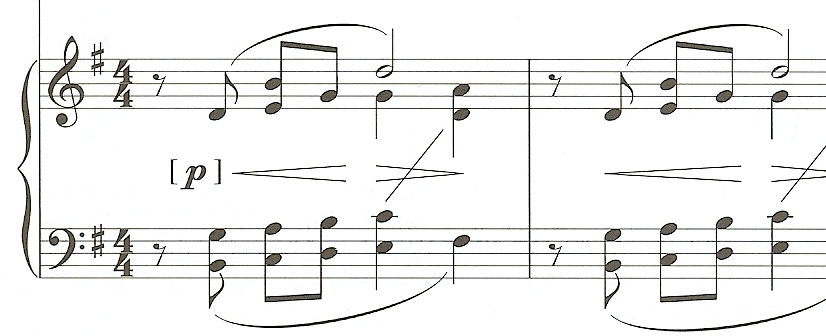
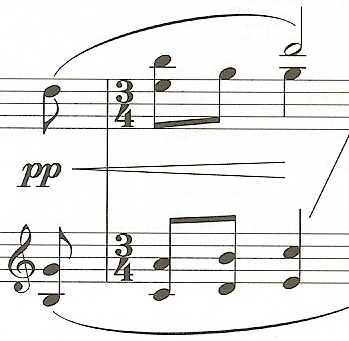
For additional comments about the specific sections of the song and other information about the form please refer to: Structure - Van der Watt.
Rhythm: The use of rhythm in the vocal line and even more so in the piano accompaniment is quite diverse in this song. The rhythmic durations are common for Finzi but he uses more rhythmic motifs and variety than is typical for one of his songs. Within this set, "Let me enjoy the earth" and "In years defaced" are close in there use of rhythm but this song still has more variety. The first section of the song is very calm rhythmically but Finzi becomes increasingly more active rhythmically in the second section even to the point of being quite dramatic in measure ten with a flourish of sixteenth notes and a crescendo from mezzo-piano to forte in four beats (see example below).
Rhythmic activity in measure 10. (Finzi, 104)
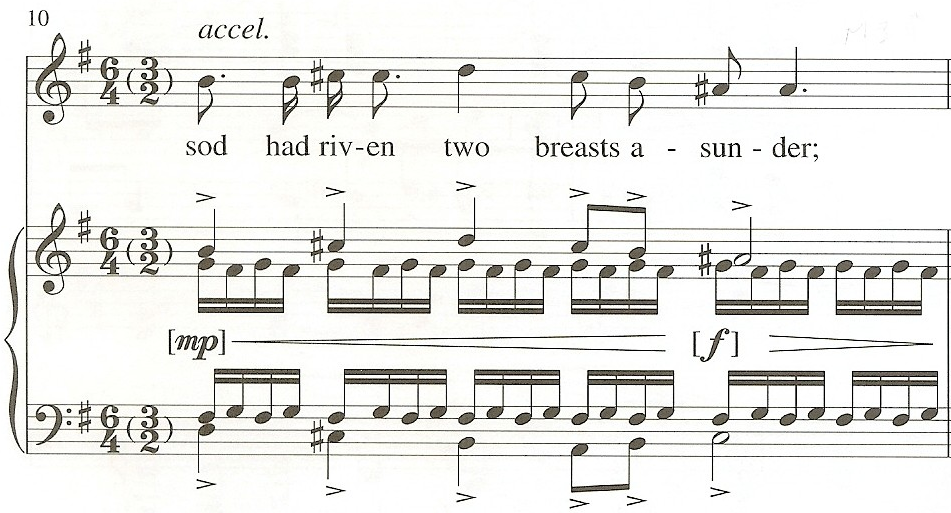
The rhythmic activity in measures twenty-one and twenty-two, although not as dramatic as measure ten, is nevertheless worth noting (see example below).
Rhythmic activity in measure 21-2. (Finzi, 105)

Some of the more unique uses of rhythm and displays of Finzi's ability to set the text idiomatically and at the same time dramatically correctly occurs in measures 8-9 and 13-6 (see example below).
Text setting in measures 8-9. (Finzi, 104)

Text setting in measures 13-6. (Finzi, 104)


For additional comments about the rhythm and the rhythmic motifs of the song please refer to: Rhythm - Van der Watt.
A rhythmic duration analysis was performed and for the results please refer to: Rhythm Analysis. Information contained within the analysis includes: the number of occurrences a specific rhythmic duration was used; the phrase in which it occurred; the total number of occurrences in the entire song.
Melody: The melodic material found in the vocal line is at times more angular than Finzi's normal treatment but there is still a large amount of stepwise movement. The accompaniment at times has the majority of the melodic material due in part to Finzi setting the text on a unison pitch. When these passages occur it gives the song a parlando feel while helping facilitate the declamation of the text. Consequently, Finzi had to write a more complicated accompaniment than is typical for him to balance the melodic interest. There are a couple of good examples of his parlando writing for the voice. The first example occurs at the beginning of the third section where the text "I walked along a terrace" and then in the last section with the text "too regretful mood" (see examples below).
Parlando writing in measure 14 and measure 26. (Finzi, 104-5)

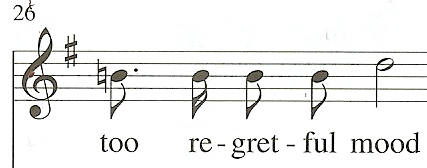
For additional comments about the melodic material within the song please refer to: Melody - Van der Watt.
An interval analysis was performed for the purpose of discovering the number of occurrences specific intervals were used and also to see the similarities if there were any between stanzas. Only intervals larger than a major second were accounted for in the interval analysis. For a complete description of the results of the interval analysis please see the table at the bottom of the page or click on: Interval Analysis.
Texture: The vocal line is well supported homophonically but the piano accompaniment is quite often a contrapuntal texture. For a brief description about the texture including a table outlining the types of texture and the percentage in which they were used please refer to: Texture - Van der Watt.
Vocal Range: The vocal range spans an interval of a perfect twelfth. The lowest pitch is the C below middle C and the highest pitch is the G above middle C in the high edition. The medium/low voice edition is a minor third lower.
Tessitura: The tessitura spans a minor tenth from the D below middle C to the F above middle C. A pitch analysis was performed for the purpose of accurately determining the tessitura and for the complete results please refer to: Pitch Analysis.
Dynamic Range: For a discussion about dynamics including a table listing where each dynamic is indicated within each stanza please refer to: Dynamics - Van der Watt.
Accompaniment: The piano accompaniment is quite difficult with numerous shifts in meter and tempo as well as contrary motion between hands in measures ten and eleven also measures twenty-one and twenty-two are tricky as well. Several times in the song there are staccato indications and these should be observed because they also serve as a unifying rhythmic motif. For specific information about the accompaniment please refer to: Accompaniment - Van der Watt.
Published Comments: Stephen Banfield writes in his Finzi biography: "Finzi's revisited haunts, rather as in 'I say I'll seek her', are a handful of his best idiomatic fabrics - bits of ditty, aria, wistful trope, melodramatic piano figuration, 'stride' for the loud gambolling children, syncopated sonata subject for the life force, and shy pastoral pastel for the missing self or beloved. Miraculously he manages to cram all these into a short song held together by the last of his clock chimes - joyful and rising - and the tiniest scrap of 'aria' head motif signified by a staccato quaver bass, with perfect word-setting and without a whiff of staleness."
(Banfield, 476)
Pedagogical Considerations for Voice Students and Instructors: The range is not an issue with this song for either the tenor voice in the high key or for the baritone voice in the medium/low key. However, the tessitura is quite large and almost encompasses the entire range of the song. The dynamics may also create some challenges for the voice. For example, measure eleven with the text "daisies" with a piano dynamic in the accompaniment and then a forte in measures fifteen and sixteen with the text, "Loud children gambolled in the sun." Both spots can be negotiated very well with good breath management and should present no problems for advanced singers.
Dr. Mark Carlisle records in his dissertation the following observations and advice: "This song should be considered of an average-to-moderate degree of difficulty for a young tenor. The technical demands with respect to both range and tessitura are not extensive, but because of constant meter changes, the singer must have an above average ability to handle rhythmical change as well as a strong sense of proper textual stress and inflection. The singer also needs a somewhat mature awareness of phrasing in order to render an interpretively strong performance of this song. Although the piece has only four major sections, within each section are often short phrases that must be both musically and vocally addressed. This piece is technically well-suited for most tenor voices except the heaviest, so the decision as to its suitability should be based primarily upon maturity of musical and interpretive skills. It is certainly more than appropriate for a young graduate student, but could also be performed quite well by third or fourth year undergraduate with the necessary interpretive tools previously mentioned." (Carlisle, 82-3)
✦✼✦✼✦✼✦✼✦✼✦✼✦✼✦✼✦✼✦✼✦✼✦✼✦✼✦✼✦✼✦✼✦✼✦
Below one will find excerpts from unpublished dissertations. The excerpts should provide a more complete analysis of Life Laughs Onward for those wishing to see additional detail. Please click on the link or scroll down.
Gerhardus Daniël Van der Watt - The Songs of Gerald Finzi (1901-1956) To Poems by Thomas Hardy
✦✼✦✼✦✼✦✼✦✼✦✼✦✼✦✼✦✼✦✼✦✼✦✼✦✼✦✼✦✼✦✼✦✼✦
✦✼✦✼✦✼✦✼✦✼✦✼✦✼✦✼✦✼✦✼✦✼✦✼✦✼✦✼✦✼✦✼✦✼✦
Audio Recordings
The Songs of Gerald Finzi to Words by Thomas Hardy
|
|
|
|
Gerald Finzi Song Collections |
|
|
|
The English Song Series - 16 |
|
|
|
Song Cycles for Tenor & Piano by Gerald Finzi |
|
|
|
Oh Fair to See: Songs by English composers |
|
|
|
Songs of the Heart: Song Cycles of Gerald Finzi |
|
|
|
✦✼✦✼✦✼✦✼✦✼✦✼✦✼✦✼✦✼✦✼✦✼✦✼✦✼✦✼✦✼✦✼✦✼✦
The following is an analysis of Life Laughs Onward by Gerhardus Daniël Van der Watt. Dr. Van der Watt extended permission to post this excerpt from his dissertation on October 8th, 2010. His dissertation dated November 1996, is entitled:
The Songs of Gerald Finzi (1901-1956) To Poems by Thomas Hardy
This excerpt comes from Volume II and begins on page four hundred eight and concludes on page four hundred sixteen of the dissertation. To view the methodology used within Dr. Van der Watt's dissertation please refer to: Methodology - Van der Watt.
1. Poet
Specific background concerning poem:
"The poem comes from Moments of Vision (1917) and is undated. Martin Seymour-Smith says of the publication:"
(Van der Watt, 408)
"Many of the poems in Moments of Vision, published on 30 November 1917, were of recent vintage." (Seymour-Smith, 848) (Van der Watt, 408) |
"The fixation on the past, which Hardy experienced in the years after his first wife, Emma's death, prompted him to take several formal and informal, physical and mental journeys into the past. The poem, Life laughs onward, is sufficiently generalized as an example of such a journey, "Rambling I look for an old abode . . " "
(Van der Watt, 408)
2. Poem
"The persona of the poem, not necessarily the poet, visits a sight where he believes the home of a departed acquaintance, to be. The house he knew does not exist any longer and in its place a new one has been erected. Not even the friend's grave is visible, there are wild flowers obscuring it. The persona meets some of the new inhabitants: noisy children, none of whom miss the previous inhabitant. These observations have a surprisingly positive outcome. The persona realizes that life continues, unperturbed by his personal feelings of regret. Age must make way for youth - and age-old natural principle - and with this realization the persona's gloomy mood vanishes."
(Van der Watt, 408)
"The poem has lyrical, narrative style."
(Van der Watt, 409)
"The poem consists of four quatrains the final line of each being shortened. The rhyme scheme is rounded: abab cdcd efef ghgh. The textual metre is mainly iambic with a spondaic instance in each stanza. A number of effective contrasting images or concepts occur in the poem.
Stanza 1 |
"Old . . . new" - referring to the house |
|
Stanza 2 |
"breasts asunder . . . Daisies throve gaily" - death/life contrast |
|
Stanza 3 |
"Loud children . . . figure" - active, young/passive, old contrast |
|
Stanza 4 |
"Old . . . Young" "Life laughed . . . regretful mood" |
|
(Van der Watt, 409)
|
||
"The simple structure and rhyme scheme, enhanced by a lyrical narrative tone, supports the content well. A potentially painful journey of remembering, turns into an uplifting experience for both persona and reader. The redeeming realization that life goes on despite private misfortunes or regrets, ends the poem positively."
(Van der Watt, 409)
Setting
1. Timbre
VOICE TYPE/RANGE
"The poem is set for tenor voice and the range is a perfect twelfth from the first C below middle C."
(Van der Watt, 409)
"The highest pitch used in the song is the third D above middle C in the second-last bar (b. 28) as part of the postlude, which is a transposition of the opening bar one octave higher. Other high pitches (the second G above middle C) occur in bar 15, the vocal climax of the song. The lowest pitch, the third G below middle C. occurs in the same vicinity (b. 16), but is the exception rather than the rule. The middle to lower sonority of the piano is favoured - extremes are largely avoided. There are no indications for the use of pedal but abundant of legato indications. The slur over the bass part in bars six and seven certainly suggests the use of pedal."
(Van der Watt, 409)
"There are a substantial number of staccato indications (b. 3, 5, 8, 9, 11, 14 and 26) which occur on a recurring motif in the bass part. It is significant to note that on three occasions, the text accompanying this staccato bass-motif deals with the persona's walking or movement: bar 3 "Rambling", bar 9 "I went where" and bar 14 "I walked along". Another bar containing staccatos, bar 11, occurs with the text, "Daisies throve gaily there". The use of staccato touch, is associated with positive movement and helps to create an atmosphere of lightness in the song. A number of portamento accents are used (b. 5, 11(voice), 12, 13, 15, 16 and 24). Their function is mildly to accentuate certain pitches or melodic fragments, the most important of which are the nine indications in bars 15 - 16 where the main climax of the song occurs. Only one bar (b. 10) contains stronger accents (>) but in that bar there are twelve. These accents occur with the dramatic line: "the sod has riven two breasts asunder", and accentuates the soprano and bass parts against a dissonant tremolo figure in the inner voices."
(Van der Watt, 409)
"The atmosphere, created largely in the piano part, changes with the developing narrative. It starts out pensive but becomes positive and pleasantly surprised at times (b. 21). A short summary of each stanza will illuminate the swiftly changing atmosphere."
Stanza 1 |
Pensive, thoughtful, rambling |
|
Stanza 2 |
Expectant (b. 9), dramatic (b. 10), light (b. 11) |
|
Stanza 3 |
Mild surprise, noisy (b. 15-6), pensive (b. 19 espress.) |
|
Stanza 4 |
Pleasant surprise, mildly dramatic (b. 23-4), positive |
"The piano part has a bar of complete silence (b. 24⁴- 25⁴) in which the words "Twas well", sounds in the vocal part. This pause, following the dominant major-minor chord, is particularly effective in isolating and emphasizing this unusually positive utterance by Hardy. The interval of a perfect fifth occurs sporadically in the piano accompaniment and thereby gains some prominence. The interval, especially in its ascending form, embodies movement or activity which in turn enhances the positive atmosphere in the song."
(Van der Watt, 410)
2. Duration
"The mostly iambic textual metre is reflected in the use of a common-time time-signature in 25 of the bars. Metre variations are summarized below:"
Bar no. |
Metre |
No. of bars |
Total |
Suggested reason/s |
8 |
5/4 |
2 |
4 |
Bar extended to accommodate interlude |
10 |
6/4(3/2) |
1 |
1 |
Extension to follow textual rhythm |
11 |
4/4 |
1 |
18 |
"Daisies" on a strong beat |
12 |
3/4 |
1 |
6 |
Shortened line of text |
113 |
4/4 |
2 |
Slight pause before stanza 3 |
|
15 |
3/4 |
2 |
"Laud" on a strong beat |
|
17 |
4/4 |
2 |
"figure" on a strong beat |
|
19 |
3/4 |
1 |
"none" on a strong beat |
|
20 |
5/4 |
1 |
Extend interlude |
|
21 |
4/4 |
2 |
"Life" on a strong beat |
|
23 |
5/4 |
1 |
Bar extended for vocal pause |
|
24 |
4/4 |
4 |
"Young" on a strong beat |
|
28 |
3/4 |
2 |
So the final chord is on a strong beat |
"The musical metre follows the textual metre carefully hence the relatively large number of metric variations."
(Van der Watt, 410)
Rhythmic motifs
"The rhythmic motif consisting of four quavers (in most cases furnished with staccatos) occurs 11 times (b. 3, 4, 5, 6, 8, 9, 11(2), 14, 15 and 26) mostly in the piano part. A less prominent motif (motif 1) consisting of a quaver, crotchet and quaver occurs eight times (b. 3, 5, 8, 12, 19(2) and 20(2)). Both these motifs, even with their not so prominent recurrence, play a vital role in the establishment of unity in the song. Motif 3, consisting of four semi-quavers occurs 23 times (b. 9, 10(12), 11(4), 15(varied), 16(2-varied), 21, 22 and 23) and is largely confined to bars 10 - 11. In bar 10, specifically, the increased rhythmic activity of the motif supports the content of the dramatic line. "The sod has riven two breasts asunder". A similarly more active motif consisting of semi-quaver, quaver and semi-quaver (motif 4) occurs 12 times (b. 21(6)) but this time is related to the positive text: "Life laughed and moved on unsubdued".
(Van der Watt, 410-1)
Rhythmic activity vs. Rhythmic stagnation
"Generally speaking, the rhythmic activity varies although the quaver movement is the most prominent. The two more active sections and the relation to the textual meaning, have been discussed in the previous paragraph. There are two less active moments: bars 24-5 where the piano is totally inactive to ensure the prominence of the accompanying melodic fragment and text and the final bar, which simply announces the end of the song."
(Van der Watt, 411)
Rhythmically perceptive, erroneous and interesting settings
"The following words have been set to music perceptively:"
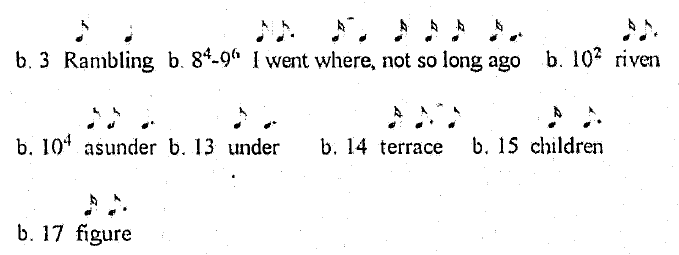 (Van der Watt, 411)
(Van der Watt, 411)
Lengthening of voice consonants
"The following words containing voiced consonants have been rhythmically prolonged in order to make the word more singable:"
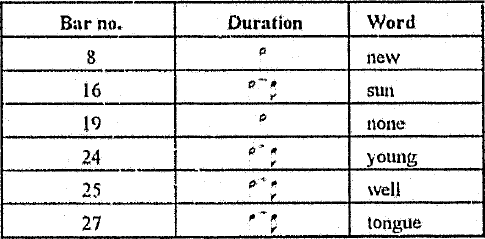
(Van der Watt, 411)
"The tempo indication is Andante commodo [quarter note equals] c. 60. Tempo deviations are listed below:"
Bar no. |
Deviation |
Bar no. |
Return |
Suggested reason/s |
10 |
accel. |
- |
- |
Dramatic elements in text |
12 |
ritard. |
13⁴ |
a tempo |
Support text: "no grave" |
20 |
poco ritard. |
21 |
a tempo |
Emphasis, opening of final stanza |
28 |
Ritard. |
- |
- |
Anticipate the final chord |
3. Pitch
Intervals: Distance distribution
Interval |
Upwards |
Downwards |
Unison |
(27) |
|
Second |
21 |
144 |
Third |
11 |
12 |
Fourth |
5 |
1 |
Fifth |
3 |
8 |
Sixth |
4 |
1 |
Seventh |
0 |
0 |
Octave |
2 |
2 |
"There are 27 repeated pitches (or 24% of the total number), 46 rising intervals (or 42%) and 38 falling intervals (or 34%). The smaller intervals (a third and smaller) account for 85 intervals (77% of the total number) while the larger intervals (fourths and larger) account for 26 (or 23%). the figures show a fairly sympathetic approach to the voice, although there are a number of prominent larger intervals, the descending perfect fifth being used the most. All the larger intervals are discussed below:"
Interval |
Bar no. |
Word/s |
Reason/s |
5th down |
3 |
look for |
Reinforce meaning |
5th down |
3-4 |
abode |
Reinforce emotional content |
6th up |
4 |
years back |
Reinforce meaning |
5th up |
8-9 |
I went |
Emphasis |
6th up |
10-1 |
asunder Daisies |
Emphasis |
5th down |
11 |
Daisies |
Reinforce emotional content |
5th down |
11 |
gaily |
Reinforce emotional content |
5th up |
12 |
no grave |
Emphasis |
6th up |
14 |
I walk |
Emphasis |
8th up |
14-5 |
where Loud |
Reinforce meaning |
4th up |
21 |
Life laughed |
Emphasis |
5th down |
22 |
moved on |
Reinforce emotional content |
8th up |
24-5 |
Twas well |
Emphasis, emotional content |
8th down |
25 |
well My |
Change of register |
6th up |
25-6 |
My too |
Emphasis |
5th down |
26-7 |
mood died |
Reinforce emotional content |
5th up |
27 |
my tongue |
Emphasis, emotional content |
Melodic curve
"A melodic curve of the vocal line is represented below. Specific indications are given to show the relationship between the melodic curve and the meaning."
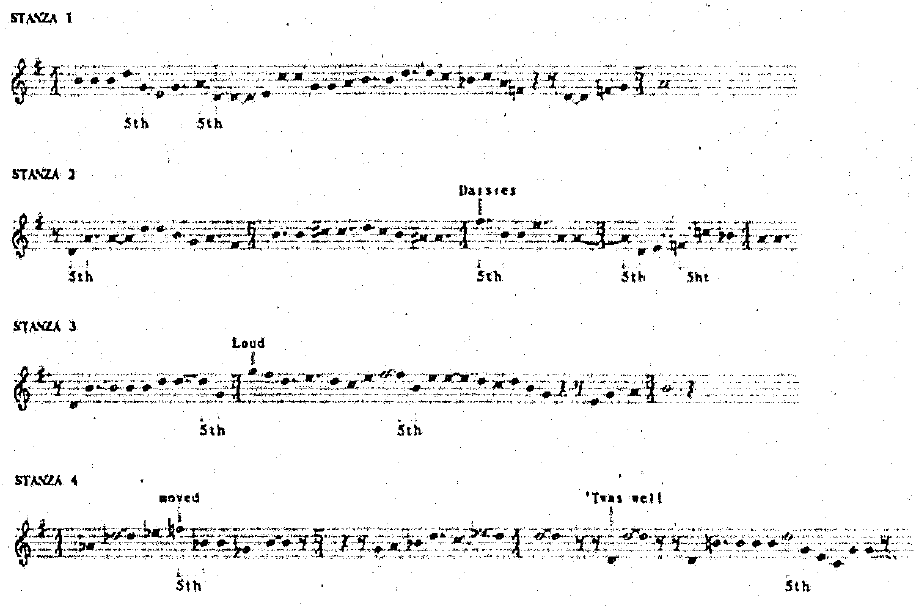 (Van der Watt, 412-3)
(Van der Watt, 412-3)
Climaxes
"The two vocal climaxes are given below:"
Bar no. |
Pitch |
Word |
15 |
G |
Loud |
16 |
F |
sun |
"The main climax on the word "Loud" is furnished with a separate f indication in the vocal part and portamento accents in the piano part."
(Van der Watt, 413)
Phrase lengths
"The vocal phrases are fairly long and careful consideration will have to be given to breathing and phrasing. Here are some suggestions over and above those indicated by rests in the score:"
Stanza 1 |
Breathe at 4² & 5⁴ |
|
Stanza 2 |
Breathe at 9⁴, 10⁶, 12¹ |
|
Stanza 3 |
Breathe at 14⁴, 16⁴ |
|
Stanza 4 |
All sub-phrases are conveniently separated by rests |
"The basic tonality of the song is G major but there are a number of modulations often abrupt and to non-related keys. All modulations are summarized below:"
Bar no. |
From - To |
Suggested reason/s |
6 |
G - F |
Support text: Arrival on the sight |
9 |
F - D (b) |
Support text: Dramatic passage |
11 |
D (b) - d |
Support text: Reference to the grave |
13 |
d - G |
In anticipation of stanza 3 |
19 |
G - E |
Interlude, support text: "missed by none" |
21 |
E - D flat |
New stanza - positive atmosphere |
22³ |
D flat - B flat |
Enhance more positive feelings |
24 |
B flat - G |
final positive statement, back to original material |
Chromaticism
"With swift key changes, a certain amount of chromaticism seems inevitable. A number of true chromatic alterations do, however, occur where a note or notes are altered after the new key has already settled. In bar 8⁴the altered chord VII⁷ (E flat-G-B flat-D) in F major, contains characteristics of the German augmented chord in G major. The chord is used as a pivot to modulate to D major. In bar 10⁵ the A sharp is the raised leading note in b minor and is only mentioned because of the dramatic context it occurs. The G sharp is chromatic in all the possible adjacent keys (D, b, d) and is part of a 'passing chord' (c sharp-E-G sharp) when one considers the bass and alto part movement in the piano part. The D sharp in bar 16¹ augments chord I⁷ in G major on the word "sun". The D sharp is also sufficiently close to the word "gambolled" and sounds while the melodic motif on the word is imitated in the bass. It follows then,that this fairly odd chromatic note is a musical indication of the children's unruliness. The D natural, in an E major context, occurs to facilitate a modulation to D flat major. The chord is D-F sharp-A (V⁶ in G major) and it simply slips a semi-tone down to become I⁶₄in D flat major. The final chromatic note is the F natural on bar 24¹. This major-minor V⁴₆ chord occurs on the word, "Young" -musical dissonance not usually associated with youth."
(Van der Watt, 414)
HARMONY AND COUNTERPOINT
"Strings of chords in first or second inversion feature prominently in the song, for example in bar 1: I⁶ - ii⁶₅ - I⁶₄ - IV⁷₆. (Further examples occur in bars 2, 4, 10, 19-20, 21-2 and 28). Extending the triad is also a regular feature of the use of chords in the song, for instance bar 15: IV⁷-iii⁷-ii⁷. The dominant eleventh was also used on two occasions in bars 7³b and 18³. These elements of mild dissonance are, on the whole, part of Finzi's expressive chordal vocabulary."
(Van der Watt, 414)
Non-harmonic tones
"Of all the non-harmonic tones in use, the accented passing note is the most prominent. (b. 6¹ (A-bass), 6² (A-C-E- soprano), 7¹ (A-bass), 18¹ (B fat-bass))"
(Van der Watt, 414)
Harmonic devices
"There is only one example of long sustained notes, namely the dissonant tremolo pattern in bar 10 (alto and tenor part of the piano). This complex pedalpoint has a strong dramatic effect with the text: "The sod had riven two breasts asunder".
(Van der Watt, 414)
Counterpoint
"There is little exchange of material between the voice and piano. A hint at a directionally inverted melodic figure occurs in bar 16 after the melodic material in the vocal part of bar 15 on the words, "gambolled in the sun"."
(Van der Watt, 414)
"Loudness variation is given in the following summary:"
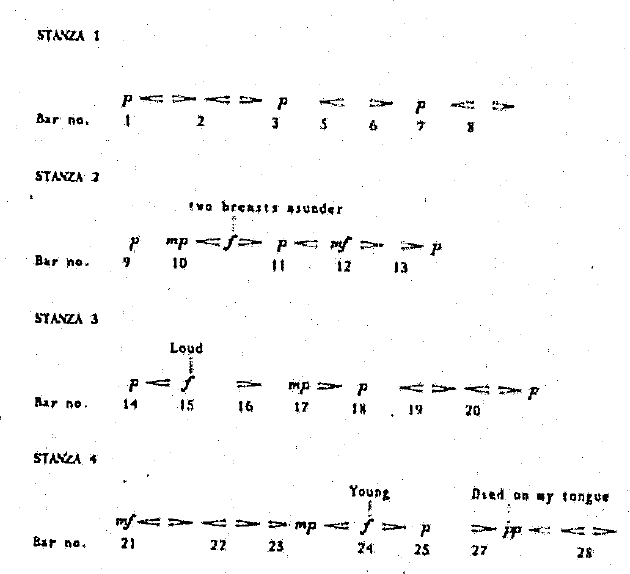
(Van der Watt, 414-5)
FREQUENCY
"There are 51 indications in the 29 bars which means that on average each bar contains more than one indication. There are a number of separate indictions for the voice (b. 14-16, at the vocal climax and 23-5). In other cases the voice should follow the indications given in the piano part."
(Van der Watt, 415)
RANGE
"The lowest level indication, pp, occurs in the third last bar (b. 27) at the start of the postlude while the loudest level, f, occurs in three places 10, 15, 24. The first occurrence is with the dramatic text, "two breasts asunder", the second occurs at the vocal climax, "Loud children" and the third on the dissonant chord with the word "Young". It is clear that significant passages in the text are highlighted by the loudest dynamic indications."
(Van der Watt, 415)
VARIETY
"The indications used are:"

(Van der Watt, 415)
DYNAMIC ACCENTS
"Portamento accents are used mildly to accentuate individual pitches (b. 5⁴, 12²b, 13²b, 24) or melodic fragments (b. 15-6¹). In the bar that sets the dramatic text: "The sod has riven two breasts asunder" a stronger accent (>) is used on six consecutive pitches of the outer voices of the piano part(b. 10). The two parts move in contrary motion and are accompanied by a tremolo motif. The accents enhance the short-lived dramatic passage."
(Van der Watt, 415)
"The density varies loosely between one and six parts including both piano and voice. The thickness of the piano part is represented in the following table:"
No. of parts |
No. of bars |
Percentage |
0 parts |
1 |
3.5 |
3 parts |
2 |
7 |
4 parts |
21 |
72.5 |
5 parts |
5 |
17 |
"Bars 24⁴- 25⁴, in which the piano part is silent, are texturally significant but have already been discussed. The three-part texture of bar 11 can be likened to the sudden lightness of the adjacent text: "Daisies throve gaily in the sun" and is further enhanced by the use of staccatos in the bass. The final chord also consists of three notes only and reaffirms the light-hearted ending to the song. The five-part texture occurs prominently with the climax of the song (b. 15-6) but on the whole the song has a four-part texture."
(Van der Watt, 415-6)
"The structure of the song is represented in the following table:"

"The song is well rounded off with the prelude and postlude material being the same. This does not, however, mean that the song has a simple ternary structure. There is some resemblance between stanzas 1 and 3 and with stanzas 2 and 4 largely different, the song has binary tendencies. There is, lastly, a very prominent bar in the accompaniment which recurs a number of times: bars 3, 8, 14, 19(varied) 20-1(varied) and 26. The prominence of this motif influences the structure considerably. It acts as a sort of short musical refrain but does not, on the other hand occur in the "right" places for the song to be strophic. No traditional term really captures the essence of the song's formal structure: it could be termed a mixture between varied strophic and through-composed procedures. The refrain-like motif and the repeated material in the postlude, are largely responsible for the coherence in the song."
(Van der Watt, 416)
7. Mood and atmosphere
"The mood shifts from being pensive and regretful to being positively encouraged and somewhat light-hearted. There is also a small amount of drama suggested in bar 10. The mood and atmosphere is closely linked to the unfolding narrative. This supported by numerous harmonic shifts. The use of a tonic chord in second inversion, abruptly modulating, can be linked, in particular, to the setting of a positive mood, this being a remnant of harmonic procedures used in the Romantic era."
(Van der Watt, 416)
General comment on style
"The vocal intervals used in the song show a reasonable sympathy towards the voice as an instrument (77% smaller intervals). The interval of a fifth becomes a prominent feature of the song both in the piano and vocal parts (11 times). There are a number of metric changes which point towards a meticulous setting of the textual metre. The most prominent harmonic feature is the incessant use of first and second inversion chords and triads which have been extended to the seventh. The different musical elements work well together to create a swiftly changing atmosphere. The structure of the song is interesting and unusual."
(Van der Watt, 416)
Unpublished Analysis Excerpts
The following is an analysis of Life laughs onward by Mark Carlisle. Dr. Carlisle extended permission to post this excerpt from his dissertation on September 7th, 2010. His dissertation dated December 1991, is entitled:
Gerald Finzi: A Performance Analysis of A Young Man's Exhortation and Till Earth Outwears, Two Works for High Voice and Piano to Poems by Thomas Hardy
This excerpt begins on page seventy-four and concludes on page eighty-three of the dissertation.
Comments on the Poem
"This poem was published as another in Hardy's collection, Moments of Vision. "Life laughs onward" was written in the months shortly after Emma Hardy's death, when Thomas had returned to Cornwall to revisit the sites of their earlier, happier days together. It describes several of these places, and remarks on how much the places had changed since the two of them had been there years before. The second verse probably describes Emma's grave in Stinsford Churchyard, as she was particularly fond of daisies, and likewise, Emma was surely the "figure" that had "once sat upon the terrace." Hardy was seventy-seven years old when this set of poems was published, and this particular one reflects not only his realization that the young will forever replace the old, such as himself, but also that this concept is acceptable to him."
(Carlisle, 74-5)
"'Life laughs onward' is the last song of Till Earth Outwears, and represents a return to the compositional characteristics found in an earlier song in this set, 'In years defaced.' These characteristics, which are heard in many of Finzi's songs, include the following: 1)short, angular vocal phrases; 2) small but distinctive musical sections; 3) chromaticism used not only to express the sentiment of an entire section, but to highlight a phrase or even a sings word; and 4) meter changes that allow for the most natural and expressive rendering of the text. The text in this song is one of poignant remembrance, as the poet sees in the present what has become of a place where years before he had spent many happy moments with a loved one. Finzi's setting provides a fitting and subtly uplifting ending to the set."
(Carlisle, 75)
"The poem is set in four distinct sections through harmonic and rhythmical means. The opening key is G major, and while the song begins and ends in this key, there are brief but clear tonicizations that temporarily lead the listener away from G major. The opening time signature is 4/4, but a rapid sequence of meter changes occurs throughout the remainder of the song. These serve to allow for natural stressing of the text, and add much variety to the musical phrasing."
(Carlisle, 75)
"The opening section, which consists of the first eight measures, presents a gentle harmonic, rhythmical, and textural structure in preparation for more interesting things to come. Measures 1 and 2 serve as a brief prelude in the tonic key, but by measure 6 the tonal center has shifted to F major. There are two characteristics deserving of mention in this section, the first of which is the use of staccato markings initially found in the bass line of the accompaniment in measures 3 and 5. This distinctive motive underlies such words and phrases throughout the song as, 'I went where, not so long ago,' 'Daisies throve gaily there,' 'I walk along a terrace,' and 'my too regretful mood died on my tongue.' While these are used only sparingly throughout the piece, they nevertheless suggest the poet's sense of 'rambling,' and provide a rather unusual means of musical unification. The second item of interest is the incorporation of B flat in to the first chord in measure 6, which effectively allows for the momentary harmonic transition form G major to F major in measures 6-8, and nicely highlights the 'newness' expressed by the poet with the words, 'Its sight a dwelling duly showed, But it was new.'"
(Carlisle, 76)
"Measure 8 serves as a short but important bridge between sections one and two, and includes the following characteristics: 1) the first meter change of the piece; 2) modulatory material to D major, the primary key of section two; and 3) the first sign of the sixteenth-note rhythms that constitute the primary rhythmical change between the first two sections."
(Carlisle, 76)
"Section two begins in measure 9 and continues through measure 13, presenting the listener with brief but noticeable changes in harmonic and rhythmical elements. One particular point of interest is the fact that there is a meter change in every measure of this section. This i unusual in any piece, even one such as this with abundant meter changes throughout, but in nevertheless allows for a great deal of variety and vitality in articulatory stressing and phrasing. A rhythmical change of even more significance is the increased and effective use of sixteenth-note patterns in the accompaniment in measures 10 and 11. This change not only adds vitality to the section, but also adds a strong feeling of textural enhancement. A slight but important harmonic change occurs at the same time in the form of an increase in chromaticism that still maintains a close relationship to D major. Together these two elements provide a marvelous musical representation of the underlying text, 'I went where, not so long ago, The sod had riven two breasts asunder.' Finzi further illustrates this text by representing 'riven asunder' through the contrary motion between hands of the accompaniment. One can easily hear in the music the sense of momentary anxiety felt by the poet when he views a familiar scene and is reminded of the painfulness of his loss."
(Carlisle, 77)
"Example 8. 'Life laughs onward,; measures 8-14.'" (Carlisle, 78) |



"This section ends in measure 13 with a D-major chord, a half-cadence in the key of G minor to which the harmony moved in measure 11. Also helping to bring this section to a close is the use of a half-note chord with no other rhythmical movement in accompaniment or voice. This technique brings all musical motion to a temporary pause, thus providing an inherent sense of phrasal ending. It is quite similar to what Finzi used very effectively to end the first section of the previous song, 'At a lunar Eclipse.'"
(Carlisle, 79)
"The third section consists of six measures, 14-19, with measures 19 and 20 again serving as an interlude in preparation for the final section. This third section is partially characterized by a very brief but important return to the staccato markings in the accompaniment in measure 14. These markings underlie the text 'I walked along the terrace,' and continue to musically represent the poet's sense of leisurely rambling. Also important is the fact that the vocal melody reaches its apex in this section. This occurs rather quickly with a pronounced octave leap to g¹ at the word 'Loud' in measure 15, followed by the highest tessitura in measures 15 and 16 under the words, 'Loud children gambolled in the sun.' Harmonically, there is no unusual chromaticism to match what was heard in section two, although the B-major chord heard in measure 16 does seem somewhat out of place until the resolution to the key of E major in measure 19."
(Carlisle, 79)
"The interlude of measures 19 and 20 provides for more unifying than transitory material due to the use of material derived from that heard in the vocal line in measure 9. These two measures remain almost entirely in the key of E major, permitting little aural preparation for the sudden harmonic shift to the key of D flat major in measure 21. While the ear may not perceive much connection between these keys, they are more closely related when considered theoretically. E major is the relative major of C sharp minor, enharmonically written as D flat minor. Finzi simply substitutes the major for the minor mode, and thus arrives at D flat major with little fanfare. Finzi obviously wanted an abrupt change of mood and thought for the words, 'Life laughed and moved on unsubdued,' and he accomplished this quite well by composing interlude material that provides no harmonic hint of the succeeding key. While interludes are often used as a means for transition to a new section, this one is used more to reflect previous musical and poetic ides than as preparation for new ones."
(Carlisle, 79-80)
"The fourth and final section that begins in measure 21 is characterized by rhythmical and harmonic change and interest. The syncopated rhythm in the accompaniment in measures 21-22 furnish the opening of this section with much energy and 'liveliness,' again and excellent musical response to the underlying text. The key of D flat major remains solidly in place until the middle of measure 23, at which time a subtle but important chromatic movement occurs leading to an unusually dissonant chord built on D in measure 24 (caused by the use of F natural, a 'blue note,' instead of F sharp in the top line of the accompaniment)."
(Carlisle, 80)
"This chord is the musical culmination of the text, 'I saw that Old succumbed to Young,' and makes the poet's momentary feeling of regret most expressive. It is harmonically important as well, for it serves to cement the tonal center of G major that concludes the piece after a brief tonicization of G minor in measure 23. It is a full half-note chord in both accompaniment and voice, followed by rests in both parts, so as in 'At a Lunar Eclipse' it brings the motion of the music to momentary pause. The voice then continues unaccompanied into measure 25 in a brief echo-like repetition of measure 24 (and its upbeat in measure 23), also quite expressively highlighting the text used as an afterthought, 'Twas well.'"
(Carlisle, 80-1)
"The vocal upbeat in measure 25 begins the last two bars of the vocal line, as the melody again provides the listener with a sense of unification through the use of a melodic fragment heard before in measures 9 and 14. The accompaniment in measure 26 returns briefly to the important 'rambling' staccati heard at key points throughout, then closes the song with a two-measure passage that imitates the opening bars of prelude and returns the listener to the gentle musical motion so reflective of this Hardy poem."
(Carlisle, 81)
"Finzi has provided in this particular song more specific tempo and musical markings than in most of the other songs in this set. The opening tempo marking of [quarter note] = c. 60 (Andante commodo) is very appropriate if given suitable expressive latitude. The opening dynamic markings in the accompaniment are indicated as piano, but there is no poetic or musical necessity for the singer to use such a soft dynamic level; the opening lines of text are primarily narrative, so a mezzo-forte is more appropriate for at least the first musical section. Though no ritardando is written at the end of the first section in measure 7, both singer and accompanist should supply some slight rubato at this point."
(Carlisle, 81-2)
"Finzi has written an accelerando in measure 10 of the second section that should definitely be observed, as well as the pronounced accent marks in the accompaniment. These are necessary to interpretively highlight and convey the sense of the "breaking of two hearts" as felt by the poet at this moment. Also very important in this section, as well as all the others, is for the accompanist to observe the staccato markings when they appear in the accompaniment. They serve not only as a means of musical unification, but also provide the listener with a strong sense of the poet's continued travelling."
(Carlisle, 82)
"Dynamic and tempo markings in both the third and fourth sections (measures 14-19 and 21-29 respectively) are very good and should be respected, particularly the dynamic markings over the text, "I saw that Old succumbed to Young: 'Twas well." It is not necessary, nor does it make musical sense, for the performer to "count out" the beats in measures 24 and 25. The singer should be free at this moment to perform these two brief measures with emphasis on musical expressiveness rather than rhythmical exactness. The powerful textual importance of the "old" giving way to the "young" can then at this moment be given its proper interpretive due."
(Carlisle, 82)
"This song should be considered of an average-to-moderate degree of difficulty for a young tenor. The technical demands with respect to both range and tessitura are not extensive, but because of constant meter changes, the singer must have an above average ability to handle rhythmical change as well as a strong sense of proper textual stress and inflection. The singer also needs a somewhat mature awareness of phrasing in order to render an interpretively strong performance of this song. Although the piece has only four major sections, within each section are often short phrases that must be both musically and vocally addressed. This piece is technically well-suited for most tenor voices except the heaviest, so the decision as to its suitability should be based primarily upon maturity of musical and interpretive skills. It is certainly more than appropriate for a young graduate student, but could also be performed quite well by third or fourth year undergraduate with the necessary interpretive tools previously mentioned." (Carlisle, 82-3)
Unpublished Analysis Excerpts
The following is an analysis of Life Laughs Onward by Leslie Alan Denning. Dr. Denning extended permission to post this excerpt from his dissertation on September 8th, 2010. His dissertation dated May 1995, is entitled:
A Discussion and Analysis of Songs for the Tenor Voice Composed by Gerald Finzi with Texts by Thomas Hardy
This excerpt begins on page eighty-six and concludes on page eighty-nine of the dissertation.
"'Life Laughs Onward' closes Finzi's Till Earth Outwears with a solemn declaration about one's destiny and an affirmation of life. Hardy's poem by the same name appears in his 1917 collection Moments of Vision, the manuscripts of which now lie in the Old Library of Magdalene College in Cambridge. The text is indicative of Hardy's views near the end of his life: a poet who has accepted the injustices of the universe, in exchange for the passing pleasures of life and memories lacking bitterness. hardy's theme is a common one: the traveller returns to the sight where someone he knew once lived, but now there is a new house. He reminisces about days gone by, but concludes that life's never ending cycle has gone one without him: other have taken over where he left off."
(Denning, 86)
"Within Hardy's poem the character comes to terms with death and the passing of time. Perhaps there was a personal message within these verses for Gerald Finzi, who composed 'Life Laugh's Onward' close to his own impending death. This song marks the beginning of Finzi's aforementioned final frenzy of song composition. Indeed, Finzi seemed driven. On March 17 through 18, 1955, Joy Finzi commented in her journal:
'Life laugh's onward,' the first song he has written in some time... a good sign and one which so often happens when he is wrestling with urgent other work." (Banfield, 297) (Denning, 87) |
"In composing 'Life Laughs Onward' Finzi employed what appear to be simple and appropriate compositional devices. Finzi presents an honest clear-eyed view of the text with an intensity that is subtle yet evident from the beginning of the song. The effect on the listener in this instance, as in so many Finzi settings of Hardy, does not end with the final cadence of the song but lingers as the listener ponders the meaning alone. Within the context of this song a scene is presented, but both poet and composer are non-judgmental. Finzi described 'Life Laugh's Onward' as suitable for either baritone or tenor. The editors have transposed the song up a tone for tenor in this set where its contrasting mood is useful."
(Denning, 87)
"The presumably happy title 'Life Laughs Onward' is not indicative of the true intent of the song, which supposes Hardy's basic philosophy of mankind full of purpose, fighting against the purposelessness and unfriendly forces of nature. In reality, perhaps this is an example of Hardy's sarcasm. The unresolved nature of the text is evident in the short piano introduction with open harmonic movements from tonic to dominant chords in the key of G-major. Here too is the typical Finzi avoidance of primary chords in root position, which continues throughout the song, as does his use of irregular meters inserted to provide ease of text. Special attention is aroused with the beginning of each verse as Finzi forays into different key centers: first to D-major in verse two, back to G in verse three, then on to D-flat for the last verse which provides a route eventually to the original key for the final statement of text. Hardy's ominous text is reflected by another typical device evident here: his use of a quiet ending employing a recitative-like passage and a final authentic cadence where the tonic chord is presented in root position. Of particular interest is the emotional attention given to the vocal phrase 'The sod had riven to breasts asunder' by the simultaneous clashing dissonance of semi-tonal appoggiaturas (musical Example 26)."
(Denning, 88)
"Example 26: Life Laughs Onward, Measures 9-10." |
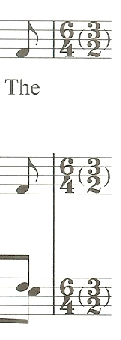
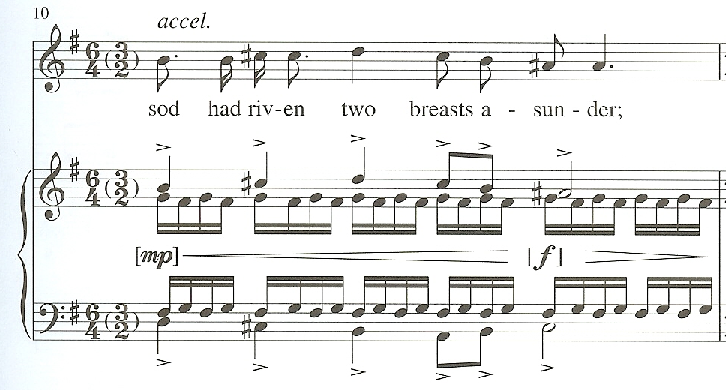
"While the text may appear less than positive, Finzi has managed to present a reflective piece which concentrates less on the tragedies of existence than on the more hopeful aspects of ongoing lives. The dramatic personal nature of the text, combined with Finzi's unaffected style, provides an emotional outlet for both performer and audience in a recital setting."
(Denning, 89)

